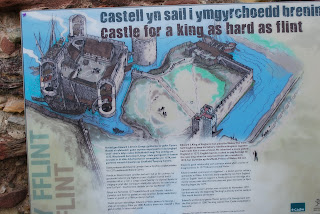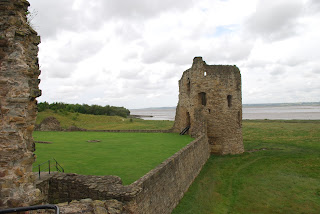Flint castle lies on the west bank of the river Dee, on the road leading to the north coast of Wales. It was one of the earliest of Edward I's Welsh castles, built in his plan to subdue and hold the rugged north of the province. From summer 1277, workmen were being recuited: diggers, masons, carpenters and smiths; and timber and stone obtained. Accounts survive showing the payment given for wages and materials; and by the time work was completed at the end of 1286, the total cost came to about £7,000. It was actually one of the cheapest and least elaborate of Edward's Welsh castles.
.
The castle takes the form of an inner ward, exactly square in shape, with round towers at the four corners. This is the north-east tower:-
and the south-west one. Apart from the southern section, the curtain walls have been reduced to ground level.
.
The most noted feature is the massive south-eastern tower, which was designed to stand as a separate fortress if needed, being separated from the rest of the castle by a moat, and reached by a drawbridge.
South of the main castle, and separated by a moat, was a large outer ward. Originally the River Dee flowed by the northern and western walls, but it has since silted up considerably, and is now some distance away
Flint was the scene of a crucial and epoch-making incident in English history in August 1399, when King Richard II, returning from Ireland, was intercepted and taken there by his cousin, Henry Bolingbroke, and held as effectively a prisoner. Richard was compelled to abdicate in favour of Henry, and taken to Ponterfract castle in Yorkshire, where he was presumably murdered soon afterwards.
.
Sunday, 3 May 2020
Subscribe to:
Post Comments (Atom)






No comments:
Post a Comment